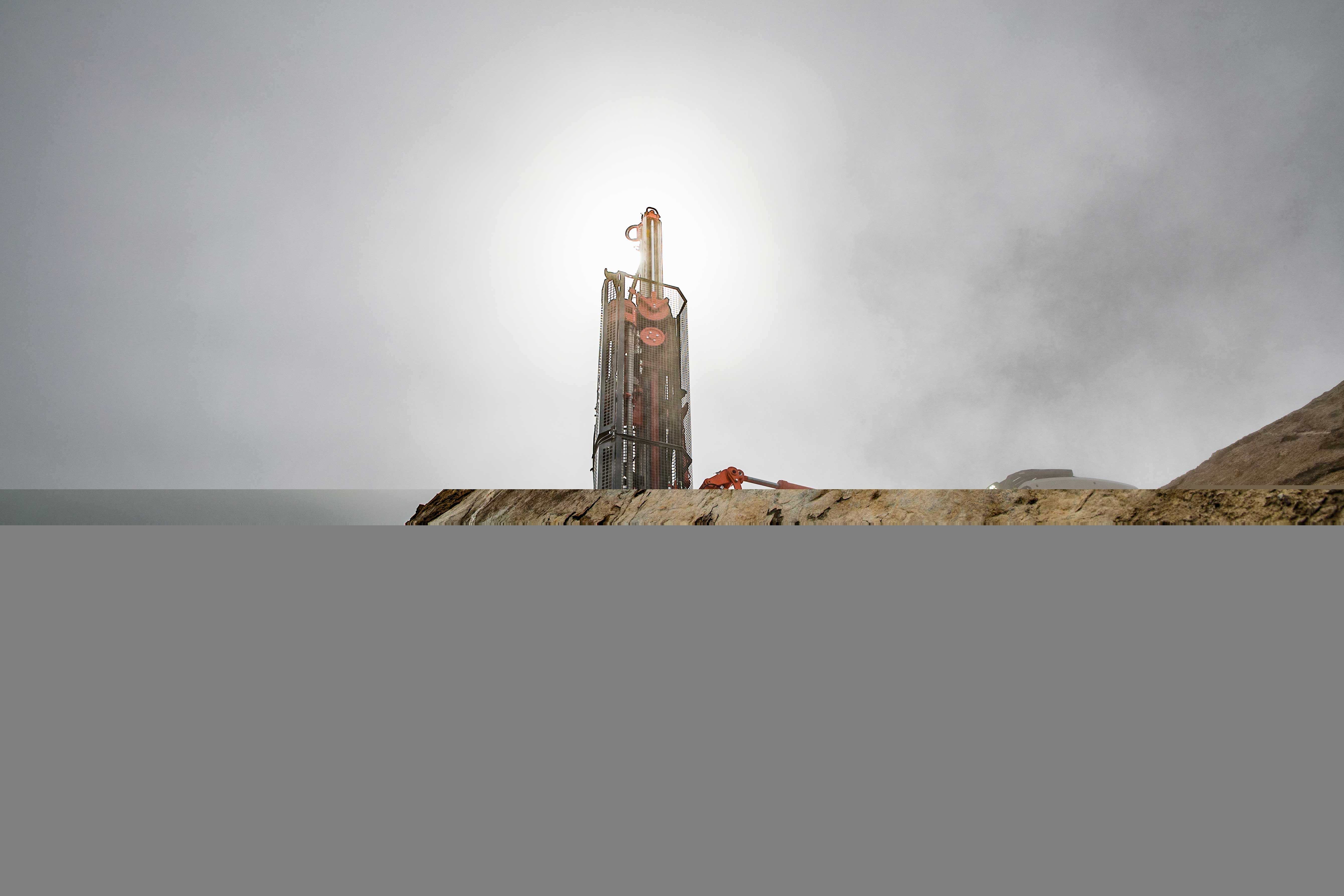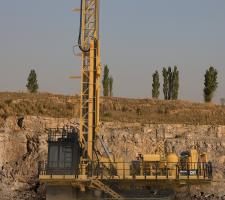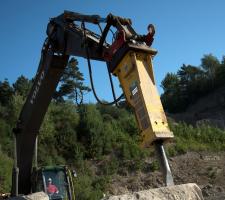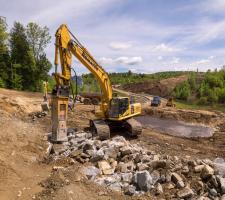
The global surface drill rigs, hammers and breakers market is vibrant, with many recent model launches by major international manufacturers. Guy Woodford and Lucio Garafalo report.
With its 290 degree revolving upper structure giving it coverage of up to 55m², the new Ranger DXi surface drill rig from
Launched globally at the steinexpo 2017 construction materials industry exhibition in Germany (30 August – 2 September), the Ranger DXi is equipped with Sandvik GT 60 tools, further enhancing productivity with straighter 92mm-127mm holes. Additionally, the model’s iTorque control system aids applications involving difficult, high-density rock.
For the latest addition to the popular Ranger surface drill rigs series, Sandvik has installed a newly designed and more comfortable iCabin. Sandvik says it has received positive feedback on the iCabin’s good ergonomics and easy-to-use joysticks and control panels. There is also room for a trainer behind the operator seat. Furthermore, through long and successful co-operation with VTT, Finnish Technical Research Center, Sandvik has been able to lower the Ranger DXi’s noise emission to an unsurpassed level for this type of drill rig.
Building on the solid legacy of the MD6420C, the new Cat MD6310 blasthole drill is said to offer substantial technology, efficiency and productivity improvements. A key advantage of the machine, Cat Electronics delivers advanced troubleshooting for efficient drill operation and scalable automation. The building blocks include drill assist, semi-autonomous and remote control operation, and machine health reporting to improve drilling accuracy, reduce fuel consumption and lower total cost of ownership.
Ideal for 12m and 15m bench heights, the new MD6310 is application-built for efficient single pass drilling down to 13.7m or 17.5m, depending on mast configuration. Offering up to 30-degree angle holes for cast blasting, it is ideal for numerous mining applications. Reaching deeper hole depths than the MD6420C, the MD6310 better matches specific drill and blast requirements when working with electric rope shovels or other loading tools that require a tall and steep muck pile. Standard on the MD6310 is a drill depth indicator, auto level/retract, auto mast, all of which contribute to cycle time improvement.
Cat Command for drilling leverages remote and autonomous drill operation and serves as the MD6310 drill’s off-board technology foundation. Scalable solutions allow customers to select the precise level of drilling automation to match operating needs. The Drill Assist option executes all major functions for single pass drilling which automatically adapts and adjusts drill power to match the ground conditions which streamlines the entire drill cycle and lengthens bit life.
Cat Terrain for drilling guides the drill for up to four times greater pattern accuracy to ensure every hole is accurately placed and drilled to plan. Cat Terrain’s logging function ensures all production is timed, mapped and recorded. Cat Terrain’s HP GPS is said to ensure accurate hole placement based on HP GPS navigation; proper hole depth achieved using GPS to calculate and adjust based on altitude; and proper hole angle through orienting the drill heading and position.
The MD6310 offers semi-autonomous drilling of single row missions and remote control operation for remote operation missions. One remote operator station allows an operator to manage drill operations and run up to three machines simultaneously.
Standard Cat Product Link improves fleet management, allowing customers to better manage their business and day-to-day operations. VisionLink, a standard feature, grants users secure access to customisable reports and mapping, giving users equipment data critical for better fleet management.
Weighing in at 1.65tonnes, the new MB 1650 hydraulic breaker is suitable for 19-32tonne class carriers. A redesigned service window offers greater accessibility, making the attachment more maintenance-friendly. With no high-pressure accumulator, the MB 1650´s maintenance and repair costs are lower.
Breaker performance on the MB 1650 is optimised by AutoControl, an automatic piston stroke length switching system, which adjusts the output balance between impact energy and rate during operation.
Atlas Copco´s EnergyRecovery feature automatically utilises the piston recoil energy to increase the performance, without additional hydraulic input, and to lower vibrations.
The MB 1650’s integrated StartSelect valve enables the operator to adjust the hydraulic breaker start-up behaviour according to the operating condition in a few simple steps.
The new Atlas Copco hydraulic breaker is equipped with ContiLube II, a self-bleeding automatic lubrication device for optimised grease consumption and continuous lubrication.
Noise and vibration levels on the MB 1650 are minimised by the VibroSilenced Plus system, utilising non-metallic suspension arrangements to isolate the percussion mechanism from the breaker box, while also sealing all openings, guaranteeing lower noise and vibration levels.
An optional, patented dust-sealing system called DustProtector II will extend the service life of the components and reduce grease consumption. The built-in check valve reduces dust intake into the tool guiding area and the percussion chamber.
The new MB 1650 hydraulic breaker is said by Atlas Copco to be an efficient choice for a broad spectrum of applications in quarrying and mining, demolition and renovation, construction, and the metallurgical industry.
Built at the company’s Lahti factory in its native Finland, Rammer’s new Performance line will initially comprise four models - the R18P, R25P, R35P, and R45P. An additional medium-sized model will follow early in 2018, with a full range of small Performance Line models scheduled to follow shortly after.
The R18P is a 1.24tonne hammer suitable for carriers in the 15-23tonne operating weight range. The larger R25P is suitable for 20-29tonne carriers and weighs in at 1.65tonnes. Designed for carriers in the 27-40tonnes weight range, the R35P is a 2.32tonne hammer; while the 3tonne R45P is aimed at 36-53tonne carriers.
Each of the new Performance Line hammers meets Rammer’s exacting design and manufacturing standards and benefits from low operating noise levels, making them suitable for inner city and urban applications.
Robit says its new Evolution button bit series for rock top hammers applies the most advanced technology to the toughest rock conditions across the globe.
The Finnish manufacturer says the three hard-wearing series’ models – sized 48mm, 76mm Retrac and 102mm – were developed with the aid of computational fluid dynamics (CFD) simulation.
Test results of the 48mm Evolution bit in hard Scandinavian granite were said to be very impressive, with grinding intervals up to 60% longer and lifetime 20% higher compared to conventional hard rock button bits. Robit says the flow pattern of the 78mm Retrac button bit body is more even, reducing bit erosion. The bit’s pressure distribution is also more uniform, and its smoother side channels along larger main grooves increase airflow, ensuring efficient flushing.
Meanwhile, the 102mm Evolution bit was said to have shone during testing in extremely hard and abrasive rock formations in Pennsylvania, U.S.
Remaining in the U.S, located in the northeast corner of the country, New Hampshire is one of America’s smallest states. Noted for a rocky terrain, New Hampshire’s geology includes a heavy presence of metamorphic, especially igneous, rock formations, which yield different types of granite. The many quarries producing this material used in construction, such as ornamental stone and for monuments, earned New Hampshire its nickname of The Granite State. Even in areas of New Hampshire where the rock formations do not justify quarrying, the land is so rocky that any excavation job requires the removal of large boulders or extraction of rock, often with a high compressive strength.
Given the occurrence and hardness of the rock masses, blasting was long considered the only valid method for excavating to allow for civil engineering and industrial projects, as well as road infrastructure works. However, over the last decade the hammer has become more commonly used for trenching, laying utilities, excavating small- and medium-sized lots, and profiling slopes.
Parker Mullins is one professional who believes in the capabilities of hammers. After gaining valuable experience working for one of the major local contractors specialising in blasting, he decided to start his own company, New Hampshire Rock Reduction nine years ago.
Mullins was aware of the increasing difficulties using explosives due to environmental impact and a constant rise in costs; he then realised that in certain situations the hammer could offer solid advantages and, in the end, be a more efficient and less costly alternative. His conviction led him to take the next step: purchasing an
The decision was a calculated one, as he explained: “Prioritising the use of the hammer was definitely the decision that gave our company a future, as it allowed us to take on a whole set of projects that we’d otherwise be excluded from. While blasting certainly offers advantages when the job is to excavate large areas containing formations with little fracturing and certain types of very hard grey granite (over 130MPa), in other situations it’s not the best solution, especially when working in residential areas where the lots include very fractured rock masses. Preparations for blasting can also be complex; often we have to create the service road so that the drill rigs can reach the areas where the explosives are to be placed, and that translates into increases in costs and time. In those conditions, in which most of our work takes place, excavators coupled with hammers are much more productive and ensure greater profitability.”
New Hampshire Rock Reduction’s experience also demonstrates how, in certain situations, the hammer is fundamentally more efficient compared to blasting; it’s also the only method for jobs like profiling slopes or excavating rock in big areas within residential zones or areas that have a protected status: “In the job we did in Goffstown we excavated an area of over 20,000 sq. ft. This was the last lot of a project for a future real estate development, and explosives could be used only in the upper part since there was a protected wetland below. We achieved excellent productivity using the HP 16000 on the fractured granite, although the presence of mica and quartzite increased the abrasiveness of the material, which obviously had effects on the chisel. Our productivity was similar in another job in a residential area of New Boston, where we used the HP 13001 to excavate a lot containing blue granite with practically no fracturing and considerable hardness. Again, in a situation where blasting would have been im
possible, the hammer was very effective despite the fact the material had a compressive strength that tested the limits of this excavation method.”
The constant use of the hammer inevitably involves routine maintenance issues. If not met properly, those problems can firstly, result in lower productivity and secondly, affect the vital parts of the attachment. To address this, Indeco North America and its network of almost 60 dealers have always made service a priority. As Nick Davidson, sales manager of Indeco North America for New England, told us: “Our approach to service is that there are no customers with more or less importance; anyone who buys our hammers is treated equally when it comes to assistance. To ensure that, we along with our dealer network, are committed to solving problems as quickly and most effectively as possible.”
Emphasis on service is an aspect that hasn’t escaped the attention of Parker Mullins, who said: “We’re very satisfied with the Indeco product, and I’m not only referring to its quality, reliability and productivity, but also to the steady support provided by Indeco North America and the dealer Anderson Equipment, from whom we bought all three hammers.”

















